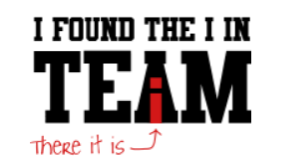Service Integration and Management (or SIAM) is a response to complex multi-sourced environments, essentially the incorporation of a service integrator, a logical entity held accountable for the end–to–end delivery of services and the business value that the customer receives. It sounds simple enough on paper, but the complexity in the ‘real world’ can make it challenging for even the most respected and impartial integrator to get providers to engage, collaborate and innovate.
As is often told: ‘There is no I in TEAM!’ (although if you look closely …

This refers to the fact that a team is not about the individual, but the collective. In SIAM we’re looking for a similar attitude, as the delivery of value to the consumer is not about the performance of an individual service provider, but rather the end-to-end delivery across all providers.
In fact, a lot of the SIAM structures, practices and behaviours mimic those of a team, with the service integrator in the role of the team manager. But, because we’re not dealing with individuals here, but with multiple service providers, the teams that need managing are cross-functional, cross-organisational and often geographically spread, sometimes virtual and often with different objectives. Throw in the additional complexity of various contracts motivating or restricting the individual providers and you start seeing how difficult it is within a SIAM environment to establish and retain a ‘one team’ focus.
Integration
Of course, there is an ‘I’ in SIAM and it stand for ‘integration’. Integration means the integration of several services (and\or providers) into a single, end-to-end service. It is important that this integration starts ‘at the top’, during the design of the service and the determination of various service groupings and the sourcing thereof.
But it is also important, and perhaps more so, that the customer provides a clear indication of the required value and outcome of the overall service. After all, many services are made up of several different components possibly sourced through a number of different providers and like doing a jigsaw, it needs to be ‘put together’ by the service integrator. Without an understanding of the required outcome or value, it is going to be difficult to determine whether the individual performance of the providers was sufficient, or to make appropriate decisions when prioritising, compromising, delegating or dealing with ad-hoc issues.
Collaboration
From integration, it’s a mere hop and a skip to collaboration, as this is what we want to happen in the operational layer of a SIAM model. SIAM is more than a contractual structure that determines the performance of individuals providers, and a service integrator that uses the stick-and-carrot to make them comply. A mature SIAM environment needs a culture of collaborating, across all parties (i.e. service providers, the service integrator and customer retained capabilities) and working towards a ‘common goal’ (or rather the determined value or outcome of the end-to-end service).
It is very possible that on occasion, one specific service provider may have to change their delivery, sometimes to ‘go the extra mile’, but conceivably also reduce their output in order to support, enable or improve the performance of another provider … all for the common good. And this adaptive mindset should be built into SIAM contracts, service and collaboration agreements (highlighting desired behaviours, improvement focus and such like). The aim is to make this part of a working approach which is embedded in and understood by the SIAM ecosystem, providers, and parties.
In Summary
SIAM is not about individual performance, not about individuals and not about individual service providers. Instead, it’s about the collective. Integration and collaboration needs to start from the ‘Plan & Build’ of the services and ecosystem and become part of the culture in ‘Run & Improve’. The new SIAM Professional Body of Knowledge provides a wealth of detail, interspersed by practical guidance and examples, along the SIAM roadmap. A must-read for those thinking of embarking on a SIAM-journey or looking for ways to improve their current multi-provider environment.
This blog was first published on Van Haren.net.
About the author
Simon Dorst has over 25 years’ international experience in IT Service Management using the PRINCE2, COBIT and ITIL methodologies. He is experienced in the development and delivery of various Service and Project Management consulting and training assignments. He is a co author of the SIAM Foundation Bok and SIAM Professional Bok and a contributing author to VeriSM.

You can purchase the Service Integration and Management Professional Body of Knowledge (SIAM™ Professional BoK, ISBN 9789401802994) here.
Or download the online versions for free here.


